Dental care
A dental visit can provide an opportunity for the provision of preventive dental care to maintain existing oral health, as well as treatment services that may reverse disease or rehabilitate the teeth and gums after damage occurs.
Dental services are funded, and can be accessed, in a number of ways – privately or through public dental clinics or DVA (based on eligibility). For those who purchased services privately, some may have had all or part of the costs of the service subsidised.
In 2021–22:
- 44.8 million dental services were subsidised by private health insurance providers (APRA 2022) – for more information refer to chapter on Private health insurance
- 4.7 million services were subsidised under the Australian Government’s Child Dental Benefits Schedule (DoHAC, 2023a) – refer to the section included below for more information on the Child Dental Benefits Schedule.
Data on dental services provided in Australia are limited, especially in relation to services provided in the private sector, as no comprehensive national data sources are available. The most complete information about Australians’ use of dental services is available via national population surveys.
Key terms
- Favourable dental visiting pattern: Visiting a dentist once or more a year (usually for a check-up) and having a usual dental provider.
- Unfavourable dental visiting pattern: Visiting less than once every two years (usually for a problem), or visiting once every two years (usually for a problem) and without a regular dental provider.
- Intermediate dental visiting pattern: Visiting classified as neither favourable or unfavourable.
National Study of Adult Oral Health
The National Study of Adult Oral Health 2017–18 (Chrisopoulos, Luzzi & Ellershaw, 2019) is a population-based survey which collected data from around 15,000 adults aged 15 years and over across Australia. Information was collected via interview and around one-third of participants underwent a dental examination. Data presented in this section was sourced from this survey.
In 2017–18, more than half (56%) of adults aged 15 years and over saw a dentist in the last 12 months
In 2017–18, the proportion of adults aged 15 years and over who had seen a dentist in the last 12 months was:
- higher for people who live in a capital city (59%) than for people who live in other places (52%)
- higher for people who had dental insurance (70%) than for people who didn’t (43%)
- higher for people who usually visit for a check-up (70%) than for those who usually visit for a problem (36%)
Explore the data further in Dental care interactive 1 below.
In 2017–18, 11% of adults aged 15 years and over last saw a dentist 5 or more years ago
In 2017–18, the proportion of adults aged 15 years and over who last saw a dentist 5 or more years ago was:
- higher for those eligible for public dental care (15%) than those ineligible for public dental care (10%)
- higher for people who had completed year 10 or less (15%) than for people who completed year 11 or more (9.8%)
Explore the data further in Dental care interactive 2 below.
In 2017–18, more than half (58%) of adults aged 15 years and over reported that they usually visit a dental professional at least once a year
In 2017–18, the proportion of adults aged 15 years and over who usually visit a dental professional at least once a year was:
- higher for people who usually visit for a check-up (76%) than those who usually visit for a problem (24%)
- higher for people with dental insurance (72%) than for those without dental insurance (41%)
- higher for people who live in a capital city (61%) than for people who live in other places (51%)
Explore the data further in Dental care interactive 3 below.
In 2017–18, more than three quarters (79%) of adults aged 15 years and over have a dentist which they usually attend
Also in 2017–18:
- 82% of adults aged 15 years and over attended a private dental practice
- 90% of adults aged 15 years and over paid for their last dental visit
- 22% of adults aged 15 years and over reported unfavourable attendance patterns
- 65% of adults aged 15 years and over usually visit a dentist for a check-up
Explore the data further in Dental care interactive 4 below.
Dental care – Interactive 1
This figure shows the proportion of adults aged 15 years and over who visited a dentist in the last 12 months, by selected characteristics. National data is presented for 2017–18. In 2017–18, 56.4% of adults aged 15 years and over saw a dentist in the last 12 months.
Dental care – Interactive 2
This figure shows the proportion of adults aged 15 years and over whose last dental visit was 5 or more years ago, by selected characteristics. National data is presented for 2017–18. In 2017–18, 11.4% of people had their last dental visit 5 or more years ago.
Dental care – Interactive 3
This figure shows the proportion of adults aged 15 years and over who usually visit a dental professional at least once a year, by selected characteristics. National data is presented for 2017–18. In 2017–18, 57.5% of adults aged 15 years and over usually visited a dental professional at least once a year.
Dental care – Interactive 4
This figure shows dental visiting patterns in the Australian population, by age groups. National data is presented for 2017–18. In 2017–18, 89.4% of adults aged 15 years and over paid for their last dental visit and 78.5% of adults aged 15 years and over have a dentist which they usually visit.
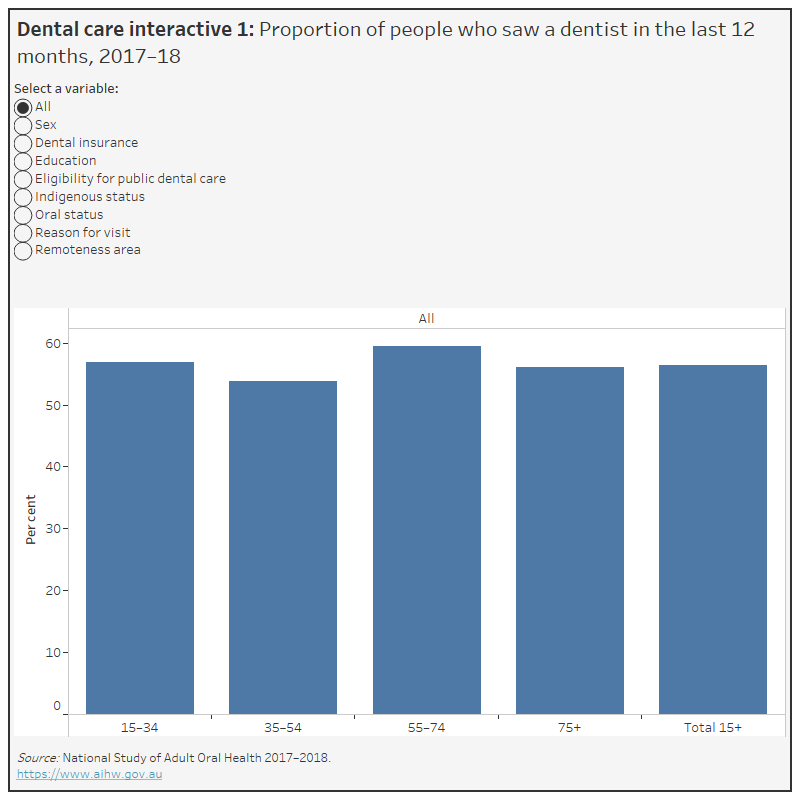
See Data tables: Dental care for data tables.
National Child Oral Health Study 2012–14
The data presented in this section were sourced from the National Child Oral Health Study (NCOHS) 2012–14 (Do & Spencer 2016). The NCOHS is a population-based survey which provides information on the oral health of children aged 5–14 years, who reside in all Australian states and territories. Information is collected using interviews and standardised dental examinations.
Dental visiting patterns
Visiting a dental provider for a check-up is considered more likely to be associated with better oral health outcomes than visiting for a dental problem. Conversely, an irregular dental visiting pattern is associated with poorer oral health outcomes.
In 2012–14, around 9 in 10 (87%) children aged 5–14 years first visited a dental provider for a check-up
In 2012–14, the proportion of children aged 5–14 years who first visited a dental practitioner for a check-up was:
- higher for non-Indigenous children (87%) than for Indigenous children (77%)
- lower for those from low income households (79%) than for those from medium income households (89%) and high income households (92%)
- lower for children whose parents had school-level education (81%) than for children of parents with vocational training (88%) and tertiary education (90%).
In 2012–14, around 8 in 10 (80%) children aged 5–14 years last visited a dental provider for a check-up
In 2012–14, the proportion of children aged 5–14 years who last visited a dental practitioner for a check-up was:
- higher for non-Indigenous children (81%) than for Indigenous children (68%)
- lower for those from low income households (71%) than for those from medium income households (81%) and high income households (88%)
- lower for children whose parents had school-level education (74%) than for children of parents with vocational training (80%) and tertiary education (84%).
In 2012–14, around 1 in 5 (21%) children aged 5–14 years had an irregular dental visiting pattern
In 2012–14, the proportion of children aged 5–14 years with an irregular visiting pattern was:
- lower for non-Indigenous children (20%) than for Indigenous children (31%)
- higher for those from low income households (32%) than for those from medium income households (19%) and high income households (13%)
- higher for children whose parents had school-level education (30%) than for children of parents with vocational training (20%) and tertiary education (84%).
Explore the data further in Dental care interactive 5 here:
Dental care – Interactive 5
This figure shows dental attendance patterns among Australian children aged 5–14 years, by selected characteristics. National data is presented for 2012–14. In 2012–14, 86.7% of Australian children aged 5–14 years had their first dental visit for a check-up and 80.2% had their last dental visit for a check-up.
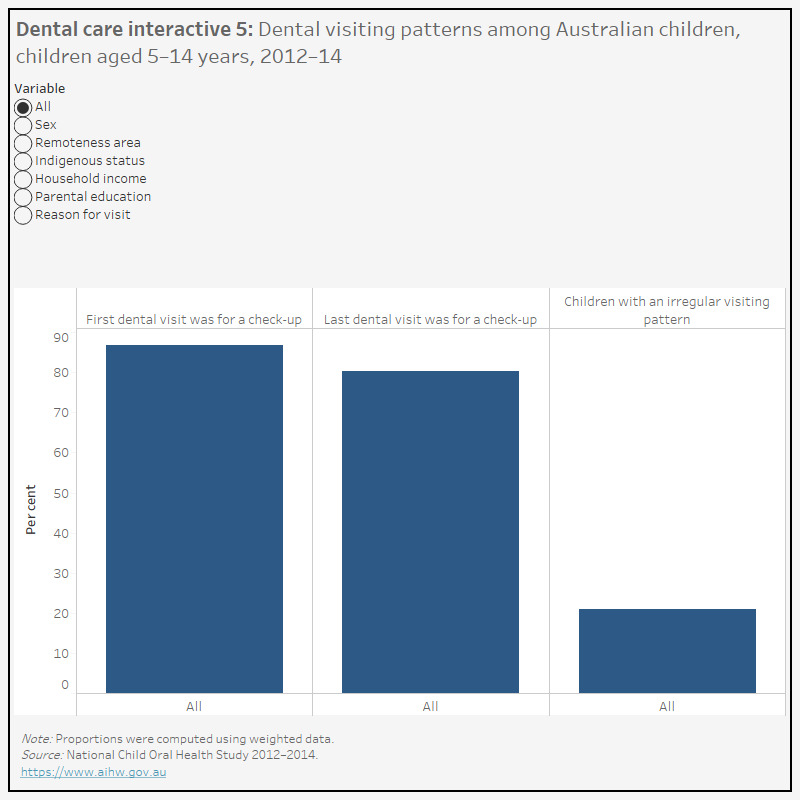
See Data tables: Dental care for data tables.
Recent dental visiting
Making a recent dental visit is indicative of access to the dental care system. In Australia, the dental care system is predominantly based in private practice on a fee-for-service basis.
In 2012–14, around 4 in 5 (81%) children aged 5–14 years made a dental visit within the last 12 months
In 2012–14, the proportion of children aged 5–14 years who made a dental visit within the last 12 months was:
- higher for non-Indigenous children (82%) than for Indigenous children (75%)
- lower for those from low income households (76%) than for those from medium income households (82%) and high income households (84%)
- lower for children whose parents had school-level education (76%) than for children of parents with vocational training (81%) and tertiary education (84%).
In 2012–14, around 3 in 5 (57%) children aged 5–14 years had their most recent dental visit at a private practice
In 2012–14, the proportion of children aged 5–14 years who had their most recent dental visit at a private practice was:
- higher for non-Indigenous children (58%) than for Indigenous children (23%)
- higher for children who resided in Major cities (62%) than for those who resided in Inner regional (51%), Outer regional (39%) and Remote or very remote (28%) areas
- higher for those children whose last dental visit was for a check-up (60%) than those who last visited for a problem (46%).
Explore the data further in Dental care interactive 6 here:
Dental care – Interactive 6
This figure shows the proportion of Australian children aged 5–14 years who last visited a dental provider within the last 12 months and whose most recent dental visit was at a private practice, by selected characteristics. National data is presented for 2012–14. In 2012–14, 56.8% of Australian children aged 5–14 years had their most recent dental visit at a private practice.
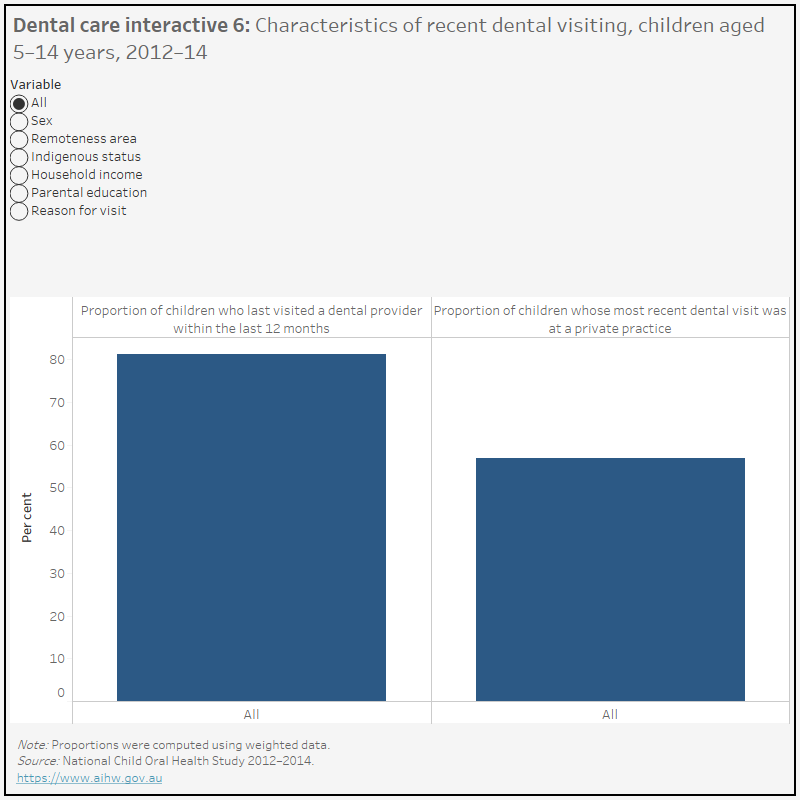
See Data tables: Dental care for data tables.
National Health Survey
The Australia-wide 2020-2021 National Health Survey (ABS 2022) conducted by the Australian Bureau of Statistics (ABS), collected a range of information about the health of Australians including their use of health services such as consultations with dentists or other dental professionals. The data presented in this section were sourced from this survey.
Box 1: National Health Survey 2020–21
Data for 2020–21 are based on information self-reported by the participants of the Australian Bureau of Statistics (ABS) 2020–21 National Health Survey (NHS).
Previous versions of the NHS have primarily been administered by trained ABS interviewers and were conducted face-to-face. The 2020–21 NHS was conducted during the COVID-19 pandemic. To maintain the safety of survey respondents and ABS Interviewers, the survey was collected via online, self-completed forms.
Non-response is usually reduced through interviewer follow-up of households who have not responded. As this was not possible during lockdown periods, there were lower response rates than previous NHS cycles, which impacted sample representativeness for some sub-populations.
Additionally, the impact of COVID-19 and lockdowns might also have had direct or indirect impacts on people’s usual behaviour over the 2020–21 period, and the module used to collect information on physical activity was changed as part of the NHS 2020–21.
Due to these changes, comparisons to previous National Health Survey data over time are not recommended.
Further information can be found at: ABS National health survey - first results methodology | 2020-21
Box 2: National Health Survey 2020–21 definitions
Alcohol consumption
The National Health and Medical Research Council (NHMRC) released Australian guidelines to reduce health risks from drinking alcohol in December 2020. Guideline 1 recommends that ‘to reduce the risk of harm from alcohol-related disease or injury, healthy men and women should drink no more than 10 standard drinks a week and no more than 4 standard drinks on any one day’. In the National Health Survey 2020-2021, exceeding the guidelines is interpreted as consuming more than 10 standard drinks in the week prior to survey, or consuming 5 or more standard drinks on any day in the last year at least monthly, or exceeding both components.
Smoker status
Smoker status refers to the frequency of smoking of tobacco, including manufactured (packet) cigarettes, roll-your-own cigarettes, cigars and pipes. In the National Health Survey 2020-21, respondents were categorised as:
- Current smoker – a respondent who smoked cigarettes, cigars or pipes
- Ex-smoker – a respondent who does not smoke currently, but previously smoked daily, or has smoked at least 100 cigarettes, or smoked pipes or cigars at least 20 times in their lifetime
- Never smoked – a respondent who has never regularly smoked daily, and has smoked less than 100 cigarettes, or smoked less than 20 pipes or cigars in their lifetime.
In 2020–21, 1 in 2 (48%) Australians had consulted a dentist or dental professional in the last 12 months
In 2020–21, according to self-reported data, the proportion of people who had consulted a dentist or dental professional in the last 12 months was:
- higher for females (52%) than males (45%)
- similar for those who exceeded lifetime risk alcohol consumption guidelines (49%) than those who did not exceed guidelines (47%)
- lower for current smokers (39%) than those who have never smoked (48%).
Explore the data further here:
Dental care – Interactive 7
This figure shows the proportion of people who saw a dentist in the last 12 months, by selected characteristics. National, state and territory data is presented for 2020–21. In 2020–21, 51.7% of females and 44.6% of males saw a dentist in the last 12 months.
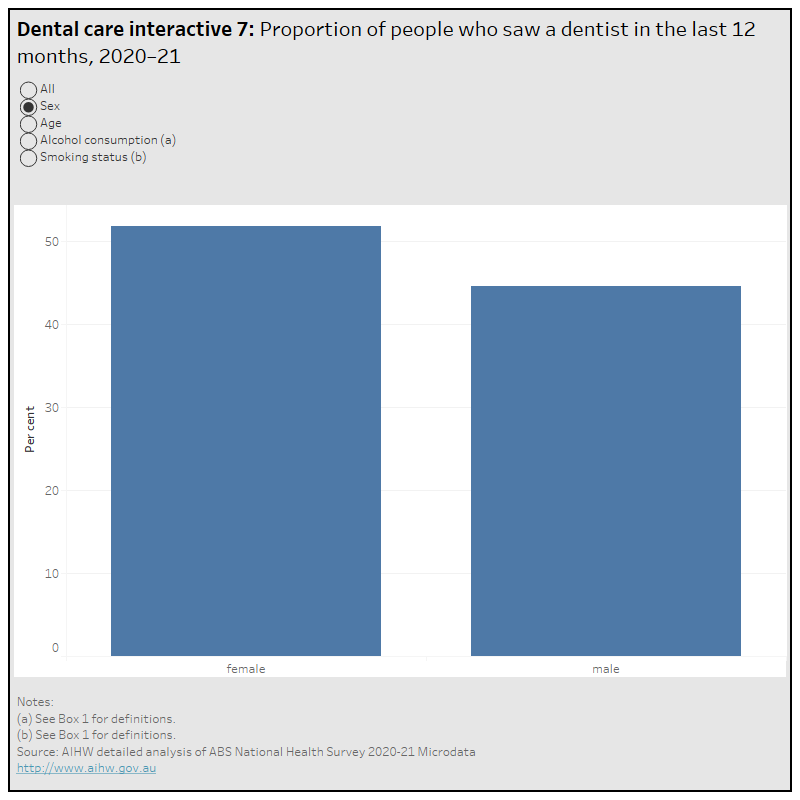
See Data tables: Dental care for data tables.
In 2020–21, around 1 in 5 (21%) Australians had last consulted a dentist or dental professional more than 2 years ago
- Around 1 in 6 (16%) children aged 2–14 years have either never consulted a dentist or dental professional or the time since they last consulted a dentist or dental professional was not known.
- Around 3 in 10 (30%) of adults aged 25–34 years last consulted a dentist or dental professional more than 2 years ago.
Explore the data further here:
Dental care – Interactive 8
This figure shows the time since last consultation with a dentist or dental professional, by sex and age. National data is presented for 2020–21. In 2020–21, 21.2% of people had seen a dentist or dental professional more than 2 years ago.
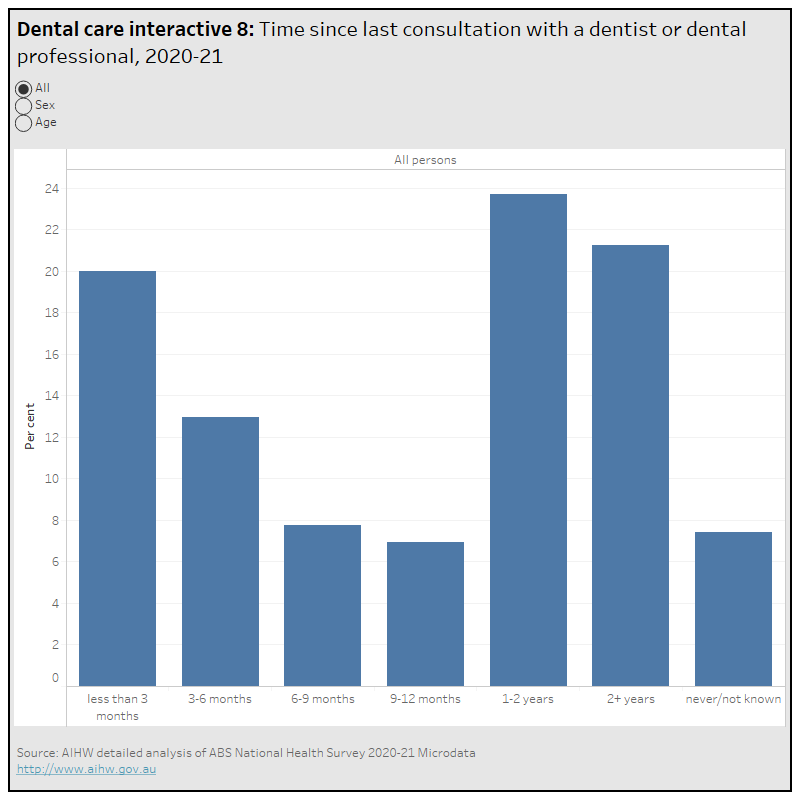
See Data tables: Dental care for data tables.
National Dental Telephone Interview Survey
Data in this section were sourced from the 2013 National Dental Telephone Interview Survey (NDTIS) (AIHW 2016) and the NDTIS component of the National Study of Adult Oral Health (NSAOH) 2017–18 (ARCPOH unpublished).
Dental services
The average number of dental visits made by dentate people aged 5 years and over, who made a dental visit in the last 12 months, remained similar across the two survey periods, 2.41 in 2013 and 2.28 in 2017–18
On average, each person had a scale and clean, around 2 in 3 had a filling and around 1 in 4 had an extraction. This was similar across both survey periods.
In 2017–18, around 1 in 3 children aged 5–14 years had a filling.
In 2017–18, around 1 in 4 males and 1 in 5 females had a tooth extracted.
There was a slight decline in the average number of fillings received by adults aged 15 years and over between 1994 and 2017–18, from 0.90 to 0.65 respectively. A similar trend was observed in children aged 5–14 years with the average number of fillings declining from 0.56 in 1994 to 0.33 in 2017–18.
Reason for last visit
Across both survey periods, nearly 2 in 3 (64%) dentate people aged 5 years and over last visited the dentist for a check-up
In 2017–18, the proportion of dentate people aged 5 years and over who last visited the dentist for a check-up decreased with age from 81% of 5–14 year olds to 53% of those aged 65 years and over. This was similar to the trend observed in 2013.
In 2017–18, more people with dental insurance last visited the dentist for a check-up (72%) than those without dental insurance (53%). This was similar to the trend observed in 2013.
In 2017–18, fewer people whose annual household income was less than $30,000 last visited the dentist for a check-up (49%) than those whose annual household income was more than $30,000. This was similar to the trend observed in 2013.
The proportion of dentate adults aged 15 years and over whose last visit was for a check-up increased from 48% in 1994 to 61% in 2017–18.
Practice type at last visit
In 2017–18, 85% of dentate people aged 5 years and over, who made a dental visit in the previous 12 months, last visited a private dental practice
In 2017–18, around 1 in 6 (16%) children aged 5–14 last visited a school dental service, and around 7 in 10 (70%) last visited a private dental practice. This was similar to the trend observed in 2013.
More people whose household income was less than $30,000 last visited a public dental service (26%) than those whose annual household income was more than $30,000. This was similar to the trend observed in 2013.
More people with dental insurance last visited a private dental practice (95%) than those without dental insurance (69%). This was similar to the trend observed in 2013.
The proportion of dentate children aged 5–14 year who last visited a public dental practice tripled over the period 1994 to 2017–18, from 5% to 14%.
Visiting patterns
Around 1 in 2 (44%) of dentate people aged 18 years and over had a favourable dental visiting pattern across both survey periods
In 2017–18, more females (46%) aged 18 years and over had favourable dental visiting patterns than males (41%). This was similar to the trend observed in 2013.
In 2017–18, more dentate adults aged 18 years and over ineligible for public dental care (47%) had favourable dental visiting patterns than those eligible for public dental care (33%). This was similar to the trend observed in 2013.
Around 4 in 10 (37%) of dentate adults aged 18 years and over without dental insurance had unfavourable dental visiting patterns compared with around 1 in 10 (11%) of those with dental insurance. This was similar to the trend observed in 2013.
The proportion of dentate adults aged 18 years and over who had favourable dental visiting patterns increased from 36% in 1999 to 44% in 2017–18.
Explore the National Dental Telephone Interview Survey data further in the three interactives here:
Dental care – Interactive 9
This figure shows the average number of dental visits and services provided for people aged 5 years and over, by selected characteristics. National data is presented for 2013 and 2017–18. In 2017-18, people aged 5 years and over made an average of 2.28 visits.
Dental care – Interactive 10
This figure shows the reason for last visit, practice type at last visit and visiting patterns, by selected characteristics. National data is presented for 2013 and 2017-18. In 2017-18, dental visiting varied by household income; people from low income households (<$30,000) were more likely to visit for a problem (50.9%) whereas people from high income households (>$140,000) were more likely to visit for a check-up (75.4%).
Dental care – Interactive 11
This figure shows the dental practitioner visiting trends for adults aged 18 years. National data is presented for 1999 to 2017-18. Between 1999 and 2017-18, the proportion of adults with favourable visiting patterns fluctuated but increased overall from 36.3% in 1999 to 43.6% in 2017-18.
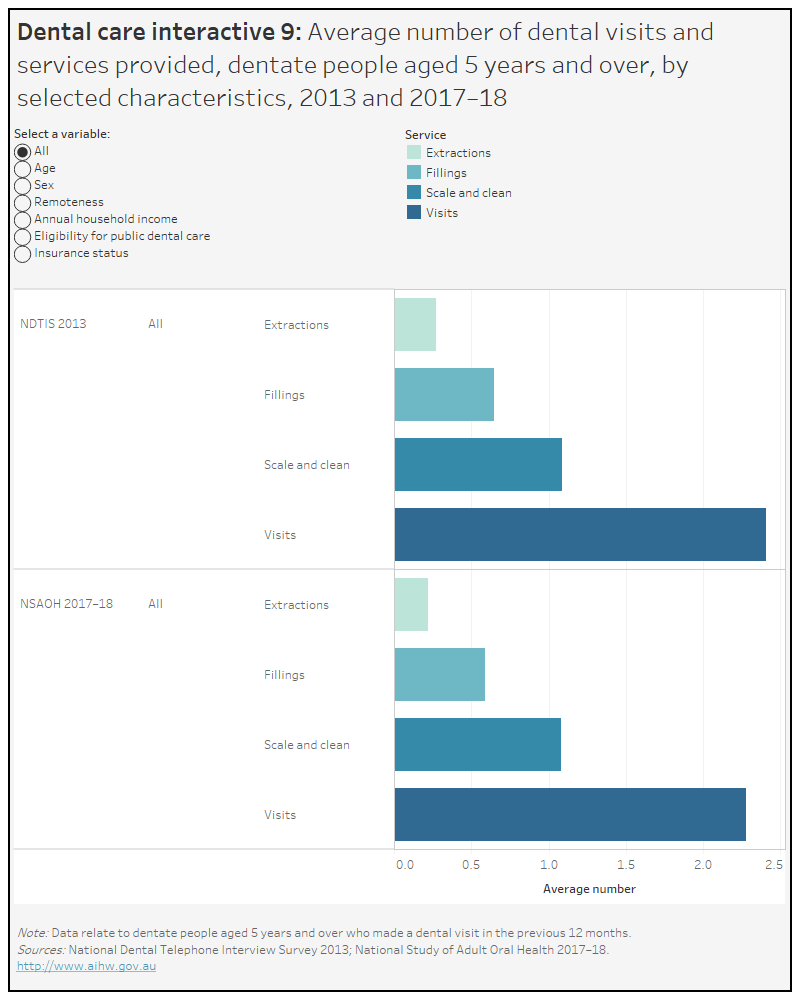
See Data tables: Dental care for data tables.
Child Dental Benefits Schedule
The Child Dental Benefits Schedule (CDBS) commenced on 1 January 2014 and provides access to benefits for basic dental services to around 3 million eligible children (DoHAC, 2023b). Basic dental services include examinations, x-rays, cleaning, fissure sealing, fillings, root canals and extractions. A child is eligible if they are aged between 0–17 years at any point in the calendar year, eligible for Medicare, and receive an eligible Australian Government payment. Eligible children have access to a benefit cap of $1,052 over a two calendar year period (DoHAC, 2023b). The payment of benefits under the CDBS is administered through Services Australia.
In 2021, around 1 in 2 (46%) children aged 0–17 years were eligible to receive services under the CDBS.
The proportion of children aged 0–17 years eligible to receive services under the CDBS ranged from 58% in Tasmania to 29% in the Australian Capital Territory.
Nationally, just over one-third of eligible children utilised the CDBS between 2018 and 2021.
Utilisation of the CDBS by eligible children differs across the jurisidctions, with those in the Northern Territory, Western Australia and the Australian Capital Territory demonstrating lower utilisation rates than the national average.
In 2022, the Australian Government paid benefits of $252.3 million in respect of 4.2 million dental services across Australia, averaging $60 in benefits per service.
In 2022:
- the average benefits paid per service ranged from $41 for a diagnostic service to $144 for a restorative service
- more diagnostic services (around 1.7 million) were provided than restorative services (around 399,000)
- the number of diagnostic examination services ranged from 2,109 per 100,000 population in the Northern Territory to 5,693 per 100,000 population in South Australia.
The COVID-19 pandemic has impacted every aspect of the Australian health system, including the provision of dental care services (refer to Impact of COVID-19 on dental services for more detail).
- In New South Wales, the number of Child Dental Benefits Schedule services fell to its lowest in April 2020 when COVID-19 restrictions were in place.
Explore the Child Dental Benefits Schedule data in the Dental care interactives below:
Dental care – Interactive 12
This figure shows the proportion of children eligible for services provided under the Child Dental Benefits Schedule in 2021. It also shows the proportion of eligible children utilising the Child Dental Benefits Schedule for each year between 2018 and 2021. National, state and territory data is presented.
Dental care – Interactive 13
This figure shows the average benefit paid per service under the Child Dental Benefits Schedule (CDBS), by type of service and sub-group. National data is presented for 2014–2022. In 2022, the average benefit paid per service under the CDBS was $60.
Dental care – Interactive 14
This figure shows the services and benefits per 100,000 population under the Child Dental Benefits Schedule, by type of service and sub-group. National, state and territory data is presented for 2014–2022.
Dental care – Interactive 15
This figure shows the impact of COVID-19 on the provision of Child Dental Benefits Schedule services. State and territory data is presented for 2018-2022.
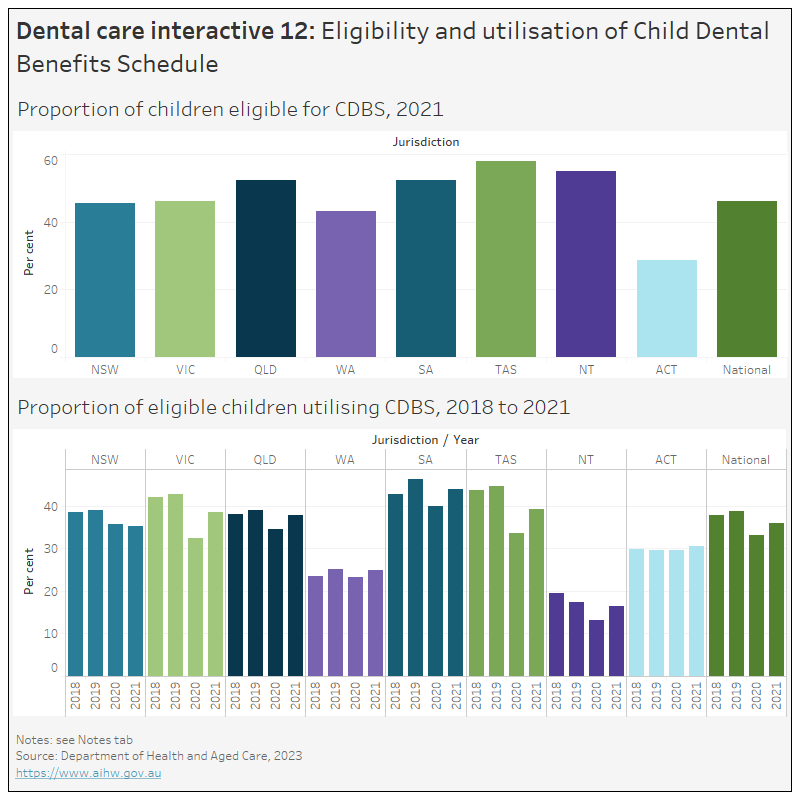
See Data tables: Dental care for data tables.
Public Dental Waiting Times
The AIHW compiles, on an annual basis, data on waiting times for adults who were placed on selected public dental waiting lists to enable monitoring of those waiting times. These data requirements are defined in the Public Dental Waiting Times (PDWT) National Minimum Data Set (NMDS) specification.
In 2018, the AIHW reported data at a state and territory level for the first 4 years (2013–14 to 2016–17) of the data collection (AIHW 2018). However, due to concerns about the comparability of the data and availability of data for some jurisdictions, the report presents the data for each jurisdiction separately, with no national data tables or comparisons between jurisdictions.
The report also examines the factors underlying the lack of comparability and availability of data – which is primarily related to the different organisation and administration of public dental waiting lists across jurisdictions.
Data from this report, and additional data for 2017–18 through to 2021–22, are presented in Dental care interactive 15 below. The data show that some people wait a considerable time before receiving care (or an offer of care).
Explore the data using the Dental care interactive 16 below.
Dental care – Interactive 16
This figure shows the public dental services and waiting times data, by type of care. State and territory data is presented for 2013–14 to 2021–22.
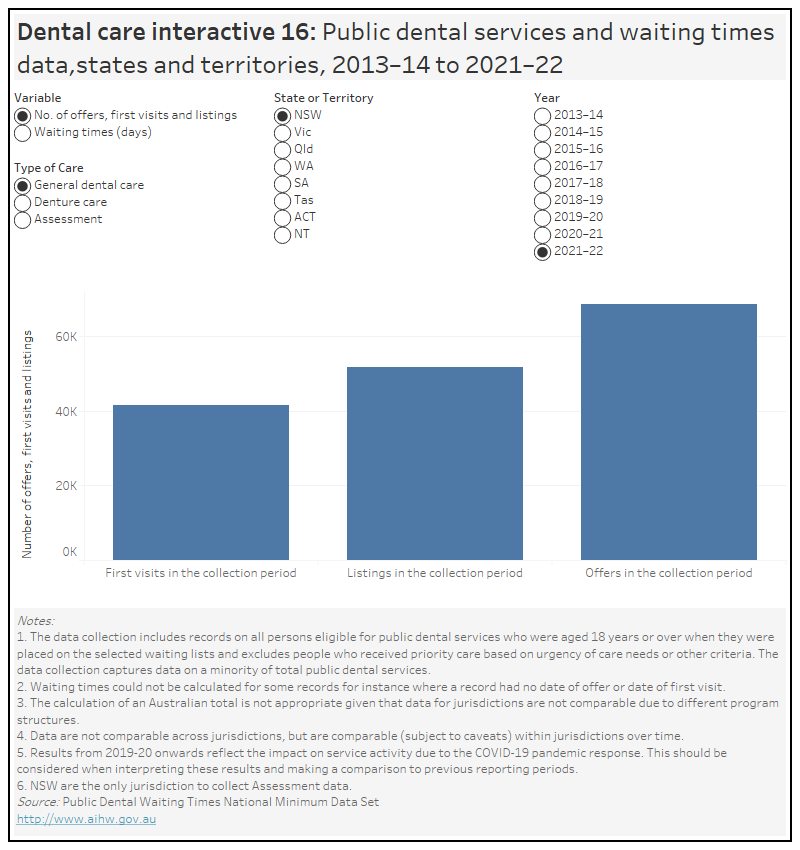
ABS (2022) Australian Bureau of Statistics (7 December 2022), Microdata: National Health Survey, 2020–21 AIHW analysis of detailed microdata, accessed 19 December 2022.
AIHW: Chrisopoulos S, Harford JE & Ellershaw A 2016. Oral health and dental care in Australia: key facts and figures 2015. Cat. no. DEN 229. Canberra: AIHW.
AIHW (Australian Institute of Health and Welfare) 2018. A discussion of public dental waiting times information in Australia: 2013–14 to 2016–17. Cat. no. DEN 230. Canberra: AIHW.
APRA (Australian Prudential Regulation Authority) 2021. Private health insurance benefits trends, September 2021: ancillary benefits. Sydney: APRA.
Chrisopoulos S, Luzzi L & Ellershaw A 2019. Dental Care. P97-124. In: ARCPOH. Australia’s Oral Health: National Study of Adult Oral Health 2017–18. Adelaide: The University of Adelaide, South Australia.
Department of Health and Aged Care (DoHAC), 2023a. Dental Benefits Schedule quarterly statistics by state and territory (June quarter 2022-23) | Australian Government Department of Health and Aged Care. Canberra: Department of Health and Aged Care. Viewed 5 October 2023.
Department of Health and Aged Care (DoHAC), 2023b. Child Dental Benefits Schedule | Australian Government Department of Health and Aged Care Canberra: Department of Health and Aged Care. Viewed 5 October 2023.
Department of Health and Aged Care (DoHAC), 2023c. Reviews of the Dental Benefits Act 2008 | Australian Government Department of Health and Aged Care. Canberra: Department of Health and Aged Care. Viewed 5 October 2023.
Services Australia 2023. Medicare Australia Statistics: Medicare Group Reports. Canberra: Department of Human Services. Data extracted on 20 June 2023 http://medicarestatistics.humanservices.gov.au/statistics/mbs_group.jsp


